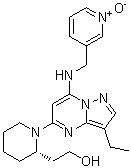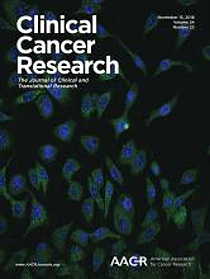
SCH727965 (Dinaciclib) is a novel small molecule multi-CDK inhibitor with low nanomolar potency against CDK1, CDK2, CDK5 and CDK9 that has shown favorable toxicity and efficacy in preliminary mouse experiments, and has been well tolerated in Phase I clinical trials. Cyclin-dependent kinases (CDK) are key positive regulators of cell cycle progression and attractive targets in oncology. SCH727965 was selected as a clinical candidate using a functional screen in vivo that integrated both efficacy and safety parameters. Compared with flavopiridol, SCH727965 exhibits superior activity with an improved therapeutic index. In cell-based assays, SCH727965 completely suppressed retinoblastoma phosphorylation, which correlated with apoptosis onset and total inhibition of bromodeoxyuridine incorporation in >100 tumor cell lines of diverse origin and background. Moreover, short exposures to SCH727965 were sufficient for long-lasting cellular effects. SCH727965 induced regression of established solid tumors in a range of mouse models following intermittent scheduling of doses below the maximally tolerated level. These results suggest that SCH727965 is a potent and selective CDK inhibitor and a novel cytotoxic agent.

Clin Cancer Res. 2018 Nov 15;24(22):5658-5672.
Increased Synthesis of MCL-1 Protein Underlies Initial Survival of EGFR-Mutant Lung Cancer to EGFR Inhibitors and Provides a Novel Drug Target.
SCH727965 (dinaciclib) purchased from AbMole
| Cell Experiment | |
|---|---|
| Cell lines | A2780 cells |
| Preparation method | dThd uptake growth inhibition assay. A2780 cells were maintained in DMEM (Cellgro) plus 10% fetal bovine serum (HyClone) and passaged twice weekly by detaching the monolayer with trypsin-EDTA (Life Technologies). One hundred microliters of A2780 cells (5 × 103 cells) were added per well to a 96-well Cytostar-T plate (Amersham) and incubated for 16 to 24 hours at 37°C. Compounds were serially diluted in complete media plus 2% 14C-labeled dThd (Amersham). Media were removed from the Cytostar T plate; 200 μL of various compound dilutions were added in quadruplicate; and the cells were incubated for 24 hours at 37°C. Accumulated incorporation of radiolabel was assayed using scintillation proximity and measured on a TopCount (Packard/Perkin-Elmer Life Sciences). The percentage of dThd uptake inhibition, relative to a vehicle control, was calculated and plotted on log-linear plots to allow derivation of IC50 values. |
| Concentrations | 0~500nM |
| Incubation time | 16 to 24 h |
| Animal Experiment | |
|---|---|
| Animal models | A2780 cells xenograft model in mice |
| Formulation | 20% hydroxypropyl-β-cyclodextran |
| Dosages | 8, 16, 32, and 48 mg/kg daily for 10 d |
| Administration | i.p. |
| Molecular Weight | 396.48 |
| Formula | C21H28N6O2 |
| CAS Number | 779353-01-4 |
| Solubility (25°C) | DMSO 55 mg/mL |
| Storage |
Powder -20°C 3 years ; 4°C 2 years In solvent -80°C 6 months ; -20°C 1 month |
| Species | Mouse | Rat | Rabbit | Guinea pig | Hamster | Dog |
| Weight (kg) | 0.02 | 0.15 | 1.8 | 0.4 | 0.08 | 10 |
| Body Surface Area (m2) | 0.007 | 0.025 | 0.15 | 0.05 | 0.02 | 0.5 |
| Km factor | 3 | 6 | 12 | 8 | 5 | 20 |
| Animal A (mg/kg) = Animal B (mg/kg) multiplied by | Animal B Km |
| Animal A Km |
For example, to modify the dose of Compound A used for a mouse (20 mg/kg) to a dose based on the BSA for a rat, multiply 20 mg/kg by the Km factor for a mouse and then divide by the Km factor for a rat. This calculation results in a rat equivalent dose for Compound A of 10 mg/kg.
| Related CDK Products |
|---|
| PF-07224826
PF-07224826 is a CDK2/4/6 inhibitor. |
| INCB123667
INCB123667 is a CDK2 inhibitor. |
| Senexin B
Senexin B is a potent, orally active CDK8/19 inhibitor with Kd values of 140 nM and 80 nM for CDK8 and CDK19, respectively. |
| Q901
Q901 is a CDK7 inhibitor for tumor-related studies. |
| NUV-422
NUV-422 is a CDK2/4/6 inhibitor that can be used in studies related to malignant gliomas. |


Products are for research use only. Not for human use. We do not sell to patients.
© Copyright 2010-2023 AbMole BioScience. All Rights Reserved.
